
Greater Queens Podiatry, PLLC
 (718) 229-0222
(718) 229-0222
 (718) 229-0222
(718) 229-0222When there is an imbalance in the size of the nail and the enlargement of the skin edge, this may cause an ingrown toenail. Reasons for this may include the nail naturally growing inward, improper shoe fitting, and hereditary conditions. Other causes may be from an improper pedicure and/or poor foot hygiene. Common symptoms can be tenderness of the nail, swelling and redness. Additionally, drainage and pus may occur if there is an infection involved. Home remedies may include soaking the affected toe in lukewarm water, or applying antibacterial ointments for bacterial infections and antifungal ointments for fungal infections. Those who have diabetes or poor circulation are advised to consult a podiatrist even if the symptoms appear to be mild.
Ingrown toenails can become painful if they are not treated properly. For more information about ingrown toenails, contact our podiatrists of Greater Queens Podiatry, PLLC. Our doctors can provide the care you need to keep you pain-free and on your feet.
Ingrown Toenails
Ingrown toenails occur when a toenail grows sideways into the bed of the nail, causing pain, swelling, and possibly infection.
Causes
Prevention
Because ingrown toenails are not something found outside of shoe-wearing cultures, going barefoot as often as possible will decrease the likeliness of developing ingrown toenails. Wearing proper fitting shoes and using proper cutting techniques will also help decrease your risk of developing ingrown toenails.
Treatment
Ingrown toenails are a very treatable foot condition. In minor cases, soaking the affected area in salt or antibacterial soaps will not only help with the ingrown nail itself, but also help prevent any infections from occurring. In more severe cases, surgery is an option. In either case, speaking to your podiatrist about this condition will help you get a better understanding of specific treatment options that are right for you.
If you have any questions please feel free to contact our office located in Bayside, NY. We offer the newest diagnostic and treatment technologies for all your foot and ankle needs.
Read more about Ingrown Toenail Care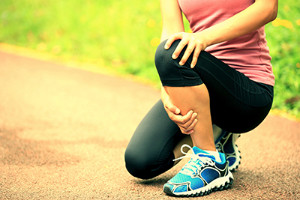 Autumn is a lovely time of the year but can present some difficulties for runners. While generally not a dangerous time to run, there are some tips one should consider to help prevent running injuries in the fall. Avoid ground that is covered in leaves. This is important, as leaves can be wet and make slips more likely. Furthermore, leaves can also cover up holes in the ground, mud, or other obstacles that can cause you to fall or hurt your foot or ankle. Another tip is to wear brighter or more contrasting colors if you run alongside a road or woodlands. This will keep you visible to drivers. Regardless of whenever or wherever you run, staying alert of your surroundings and following some basic safety tips can monumentally help prevent any running injuries.
Autumn is a lovely time of the year but can present some difficulties for runners. While generally not a dangerous time to run, there are some tips one should consider to help prevent running injuries in the fall. Avoid ground that is covered in leaves. This is important, as leaves can be wet and make slips more likely. Furthermore, leaves can also cover up holes in the ground, mud, or other obstacles that can cause you to fall or hurt your foot or ankle. Another tip is to wear brighter or more contrasting colors if you run alongside a road or woodlands. This will keep you visible to drivers. Regardless of whenever or wherever you run, staying alert of your surroundings and following some basic safety tips can monumentally help prevent any running injuries.
Exercising your feet regularly with the proper foot wear is a great way to prevent injuries. If you have any concerns about your feet, contact our podiatrists of Greater Queens Podiatry, PLLC. Our doctors will treat your foot and ankle needs.
How to Prevent Running Injuries
Many common running injuries are caused by overuse and overtraining. When the back of the kneecap starts wearing out and starts causing pain in your knee, this is commonly referred to as runner’s knee. Runner’s knee is a decrease in strength in your quadriceps and can occur if you’re not wearing properly fitted or supporting shoes. To prevent runner’s knee, focusing on hip strengthening is a good idea, as well as strengthening your quads to keep the kneecaps aligned.
What Are Some Causes of Running Injuries?
- One cause of a common running injury is called iliotibial band syndrome.
- Plantar fasciitis is also another common injury.
- Stress fractures can occur from overtraining, lack of calcium, or even your running style.
Best Ways to Prevent Running Injuries
- Wear footwear that fits properly and suits your running needs.
- Running shoes are the only protective gear that runners have to safeguard them from injury.
- Make a training schedule. Adding strengthening exercises as well as regular stretching can help keep you strong and limber and can lessen the possibility of injuries.
- Stretching keeps muscles limber; this will help you gain better flexibility.
If you have any questions please feel free to contact our office located in Bayside, NY. We offer the newest diagnostic and treatment technologies for all your foot and ankle needs.
Read more about How to Prevent Running Injuries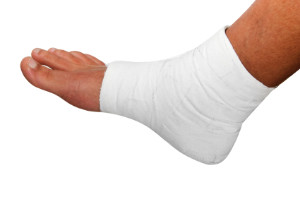 A foot or ankle sprain can be a painful condition to live with, but how can you tell whether it is just a sprain or a fracture? Some may presume that the amount of pain one experiences can indicate whether your injury is a fracture or a sprain, but this not true. A sprain can produce more pain than a fracture, so pain can only indicate that you are injured and not the severity or even the type of the injury. While both swell, fractures tend to swell more than a sprain will. Deformity is another indicator; if your foot is bent backwards or bone is showing, you very likely have a fracture and require immediate medical attention. In summary, it can be hard to tell whether you have a minor ankle sprain or a broken foot. It is recommended to see a podiatrist for either one, as they can provide immediate diagnosis and care.
A foot or ankle sprain can be a painful condition to live with, but how can you tell whether it is just a sprain or a fracture? Some may presume that the amount of pain one experiences can indicate whether your injury is a fracture or a sprain, but this not true. A sprain can produce more pain than a fracture, so pain can only indicate that you are injured and not the severity or even the type of the injury. While both swell, fractures tend to swell more than a sprain will. Deformity is another indicator; if your foot is bent backwards or bone is showing, you very likely have a fracture and require immediate medical attention. In summary, it can be hard to tell whether you have a minor ankle sprain or a broken foot. It is recommended to see a podiatrist for either one, as they can provide immediate diagnosis and care.
Ankle sprains are common but need immediate attention. If you need your feet checked, contact our podiatrists from Greater Queens Podiatry, PLLC. Our doctors can provide the care you need to keep you pain-free and on your feet.
How Does an Ankle Sprain Occur?
Ankle sprains take place when the ligaments in your ankle are torn or stretched beyond their limits. There are multiple ways that the ankle can become injured, including twisting or rolling over onto your ankle, putting undue stress on it, or causing trauma to the ankle itself.
What Are the Symptoms?
Preventing a Sprain
Treatment of a Sprain
Treatment of a sprain depends on the severity. Many times, people are told to rest and remain off their feet completely, while others are given an air cast. If the sprain is very severe, surgery may be required.
If you have suffered an ankle sprain previously, you may want to consider additional support such as a brace and regular exercises to strengthen the ankle.
If you have any questions please feel free to contact our office located in Bayside, NY. We offer the newest diagnostic and treatment technologies for all your foot and ankle needs.
Read more about Ankle Sprains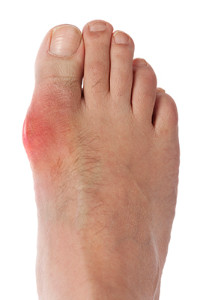 Gout, a form of arthritis, can be a painful condition to live with. Gout attacks are triggered by the buildup of uric acid crystals in the joints. There are ways to help mitigate gout symptoms, however. High levels of purines, an organic compound that is in many of the foods we eat, in the body can increase the likelihood of having a gout attack. Decreasing the amount of red meat you eat and the amount of alcohol you drink can both help decrease the likelihood of an attack. Drinking more water, eating foods with low levels of purines, and staying active can all help decrease the chances of a gout attack and will also improve your overall health. If you are experiencing pain in your foot from gout, it is recommended to see a podiatrist who can help provide treatment options and tips on how to manage your gout.
Gout, a form of arthritis, can be a painful condition to live with. Gout attacks are triggered by the buildup of uric acid crystals in the joints. There are ways to help mitigate gout symptoms, however. High levels of purines, an organic compound that is in many of the foods we eat, in the body can increase the likelihood of having a gout attack. Decreasing the amount of red meat you eat and the amount of alcohol you drink can both help decrease the likelihood of an attack. Drinking more water, eating foods with low levels of purines, and staying active can all help decrease the chances of a gout attack and will also improve your overall health. If you are experiencing pain in your foot from gout, it is recommended to see a podiatrist who can help provide treatment options and tips on how to manage your gout.
Gout is a foot condition that requires certain treatment and care. If you are seeking treatment, contact our podiatrists from Greater Queens Podiatry, PLLC. Our doctors will treat your foot and ankle needs.
What Is Gout?
Gout is a type of arthritis caused by a buildup of uric acid in the bloodstream. It often develops in the foot, especially the big toe area, although it can manifest in other parts of the body as well. Gout can make walking and standing very painful and is especially common in diabetics and the obese.
People typically get gout because of a poor diet. Genetic predisposition is also a factor. The children of parents who have had gout frequently have a chance of developing it themselves.
Gout can easily be identified by redness and inflammation of the big toe and the surrounding areas of the foot. Other symptoms include extreme fatigue, joint pain, and running high fevers. Sometimes corticosteroid drugs can be prescribed to treat gout, but the best way to combat this disease is to get more exercise and eat a better diet.
If you have any questions please feel free to contact our office located in Bayside, NY. We offer the newest diagnostic and treatment technologies for all your foot and ankle needs.
Read more about Everything You Need to Know About Gout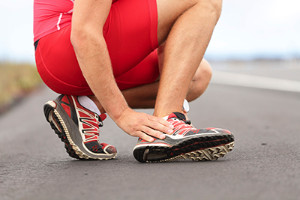 Derrick Rose of the Cleveland Cavaliers sprained his left ankle during the Cavaliers vs Milwaukee Bucks game. Rose was hit by Bucks center Greg Monroe while jumping to perform a layup in the fourth quarter. The hit caused him to land with his ankle turned inward, causing a sprain. The hit was ruled as a common foul rather than a flagrant foul. Rose left the game having scored 12 points, which helped the Cavaliers win 116 to 97. It is unknown how long Rose will be out for, if at all.
Derrick Rose of the Cleveland Cavaliers sprained his left ankle during the Cavaliers vs Milwaukee Bucks game. Rose was hit by Bucks center Greg Monroe while jumping to perform a layup in the fourth quarter. The hit caused him to land with his ankle turned inward, causing a sprain. The hit was ruled as a common foul rather than a flagrant foul. Rose left the game having scored 12 points, which helped the Cavaliers win 116 to 97. It is unknown how long Rose will be out for, if at all.
Sports related foot and ankle injuries require proper treatment before players can go back to their regular routines. For more information, contact our podiatrists of Greater Queens Podiatry, PLLC. Our doctors can provide the care you need to keep you pain-free and on your feet.
Sports Related Foot and Ankle Injuries
Foot and ankle injuries are a common occurrence when it comes to athletes of any sport. While many athletes dismiss the initial aches and pains, the truth is that ignoring potential foot and ankle injuries can lead to serious problems. As athletes continue to place pressure and strain the area further, a mild injury can turn into something as serious as a rupture and may lead to a permanent disability. There are many factors that contribute to sports related foot and ankle injuries, which include failure to warm up properly, not providing support or wearing bad footwear. Common injuries and conditions athletes face, including:
Sports related injuries are commonly treated using the RICE method. This includes rest, applying ice to the injured area, compression and elevating the ankle. More serious sprains and injuries may require surgery, which could include arthroscopic and reconstructive surgery. Rehabilitation and therapy may also be required in order to get any recovering athlete to become fully functional again. Any unusual aches and pains an athlete sustains must be evaluated by a licensed, reputable medical professional.
If you have any questions please feel free to contact our office located in Bayside, NY. We offer the newest diagnostic and treatment technologies for all your foot and ankle needs.
Read more about Sports Related Foot And Ankle Injuries Tarsal tunnel syndrome is a condition in which the posterior tibial nerve in the tarsal tunnel becomes pinched or compressed. This causes a number of symptoms including burning and shooting pain, a pins and needles sensation, numbness, and tightness in the foot. There are several reasons why the nerve could become compressed, which include bony prominences, bone spurs, abnormal heel position, and the swelling of tendons in the tarsal tunnel. Due to the nature of tarsal tunnel syndrome, diagnosis may be difficult because it can seem to mimic the symptoms of other conditions; heel pain and arch pain are some examples. It is best to see a podiatrist if you are experiencing any of those symptoms. Podiatrists can offer a number of treatments, such as orthotics, taping or bracing, rest, icing, anti-inflammatory medication, or even surgery if other treatments do not improve your condition.
Tarsal tunnel syndrome is a condition in which the posterior tibial nerve in the tarsal tunnel becomes pinched or compressed. This causes a number of symptoms including burning and shooting pain, a pins and needles sensation, numbness, and tightness in the foot. There are several reasons why the nerve could become compressed, which include bony prominences, bone spurs, abnormal heel position, and the swelling of tendons in the tarsal tunnel. Due to the nature of tarsal tunnel syndrome, diagnosis may be difficult because it can seem to mimic the symptoms of other conditions; heel pain and arch pain are some examples. It is best to see a podiatrist if you are experiencing any of those symptoms. Podiatrists can offer a number of treatments, such as orthotics, taping or bracing, rest, icing, anti-inflammatory medication, or even surgery if other treatments do not improve your condition.
Tarsal tunnel syndrome can be very uncomfortable to live with. If you are experiencing tarsal tunnel syndrome, contact our podiatrists of Greater Queens Podiatry, PLLC. Our doctors can provide the care you need to keep you pain-free and on your feet.
Tarsal Tunnel Syndrome
Tarsal tunnel syndrome, which can also be called tibial nerve dysfunction, is an uncommon condition of misfiring peripheral nerves in the foot. The tibial nerve is the peripheral nerve in the leg responsible for sensation and movement of the foot and calf muscles. In tarsal tunnel syndrome, the tibial nerve is damaged, causing problems with movement and feeling in the foot of the affected leg.
Common Cause of Tarsal Tunnel Syndrome
The Effects of Tarsal Tunnel Syndrome
A physical exam of the leg can help identify the presence of tarsal tunnel syndrome. Medical tests, such as a nerve biopsy, are also used to diagnose the condition. Patients may receive physical therapy and prescriptive medication. In extreme cases, some may require surgery.
If you have any questions please feel free to contact our office located in Bayside, NY. We offer the newest diagnostic and treatment technologies for all your foot and ankle needs.
Read more about Tarsal Tunnel Syndrome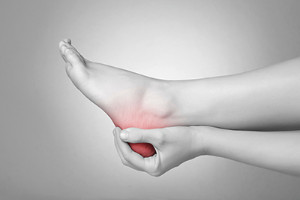 Plantar fasciitis and heel pain can both be very painful and uncomfortable. While stretching won’t eliminate the pain, it can help mitigate it. Some stretches that you can perform include the quadruped stretch, isolated calf raise, and even a foot massage. Before you do these, ask your podiatrist whether stretching is right for you. To do a quadruped stretch, get on all fours and spread your toes on the floor. Next, lean back slowly and sit on your heels while holding this position for 30 seconds. For isolated calf raises, lunge with your left leg forward and right leg back. Then, with your right foot flat, lift up onto the ball of your right foot. Do this for 10-15 reps on each side and for three repetitions. To massage your foot, push down on the center of the bottom of the foot and use a circular motion while applying pressure. These stretches will not eliminate plantar fasciitis and are only meant to temporarily reduce pain. If you have heel pain, it is recommended that you see a podiatrist who can offer effective treatment strategies.
Plantar fasciitis and heel pain can both be very painful and uncomfortable. While stretching won’t eliminate the pain, it can help mitigate it. Some stretches that you can perform include the quadruped stretch, isolated calf raise, and even a foot massage. Before you do these, ask your podiatrist whether stretching is right for you. To do a quadruped stretch, get on all fours and spread your toes on the floor. Next, lean back slowly and sit on your heels while holding this position for 30 seconds. For isolated calf raises, lunge with your left leg forward and right leg back. Then, with your right foot flat, lift up onto the ball of your right foot. Do this for 10-15 reps on each side and for three repetitions. To massage your foot, push down on the center of the bottom of the foot and use a circular motion while applying pressure. These stretches will not eliminate plantar fasciitis and are only meant to temporarily reduce pain. If you have heel pain, it is recommended that you see a podiatrist who can offer effective treatment strategies.
Plantar fasciitis can be very painful and inconvenient. If you are experiencing heel pain or symptoms of plantar fasciitis, contact our podiatrists from Greater Queens Podiatry, PLLC. Our doctors can provide the care you need to keep you pain-free and on your feet.
What Is Plantar Fasciitis?
Plantar fasciitis is the inflammation of the thick band of tissue that runs along the bottom of your foot, known as the plantar fascia, and causes mild to severe heel pain.
What Causes Plantar Fasciitis?
How Can It Be Treated?
While very treatable, plantar fasciitis is definitely not something that should be ignored. Especially in severe cases, speaking to your doctor right away is highly recommended to avoid complications and severe heel pain. Your podiatrist can work with you to provide the appropriate treatment options tailored to your condition.
If you have any questions please feel free to contact our office located in Bayside, NY. We offer the newest diagnostic and treatment technologies for all your foot and ankle needs.
Read more about Plantar Fasciitis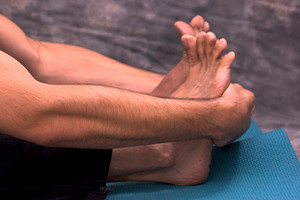 While we should all take care of our feet, those who are active should be more proactive when it comes to foot care. Athletes and physically active people generally subject their feet to more stress than an average person normally would. This can increase their risk for foot injury and ailments. Here are some tips that active people can follow to help prevent injury. Make sure to pick the right shoes for the right activity. If you run, running shoes are best; if you play tennis, go with tennis shoes. Picking a quality pair of moisture-wicking socks can also help prevent foot fungus by keeping the feet dry. Runners reportedly also often suffer from dry skin on their feet. To help prevent dry feet, use a good moisturizer. Washing them often is a good way to keep them hydrated while also helping to prevent foot and toenail fungus. If you workout, don’t forget to workout your feet. Strong feet will aid in preventing foot injuries. Upon completing a workout make sure to give your feet time to rest. Finally, if your feet hurt, stop exercising and avoid putting pressure on them. If the pain doesn't go away it is recommended to see a podiatrist.
While we should all take care of our feet, those who are active should be more proactive when it comes to foot care. Athletes and physically active people generally subject their feet to more stress than an average person normally would. This can increase their risk for foot injury and ailments. Here are some tips that active people can follow to help prevent injury. Make sure to pick the right shoes for the right activity. If you run, running shoes are best; if you play tennis, go with tennis shoes. Picking a quality pair of moisture-wicking socks can also help prevent foot fungus by keeping the feet dry. Runners reportedly also often suffer from dry skin on their feet. To help prevent dry feet, use a good moisturizer. Washing them often is a good way to keep them hydrated while also helping to prevent foot and toenail fungus. If you workout, don’t forget to workout your feet. Strong feet will aid in preventing foot injuries. Upon completing a workout make sure to give your feet time to rest. Finally, if your feet hurt, stop exercising and avoid putting pressure on them. If the pain doesn't go away it is recommended to see a podiatrist.
Everyday foot care is very important to prevent infection and other foot ailments. If you need your feet checked, contact our podiatrists from Greater Queens Podiatry, PLLC. Our doctors can provide the care you need to keep you pain-free and on your feet.
Everyday Foot Care
Often, people take care of their bodies, face and hair more so than they do for their feet. But the feet are a very important aspect of our bodies, and one that we should pay more attention to. Without our feet, we would not be able to perform most daily tasks.
It is best to check your feet regularly to make sure there are no new bruises or cuts that you may not have noticed before. For dry feet, moisturizer can easily be a remedy and can be applied as often as necessary to the affected areas. Wearing shoes that fit well can also help you maintain good foot health, as well as making it easier to walk and do daily activities without the stress or pain of ill-fitting shoes, high heels, or even flip flops. Wearing clean socks with closed shoes is important to ensure that sweat and bacteria do not accumulate within the shoe. Clean socks help to prevent Athlete’s foot, fungi problems, bad odors, and can absorb sweat.
If you have any questions please feel free to contact our office located in Bayside, NY. We offer the newest diagnostic and treatment technologies for all your foot and ankle needs.
Read more about Every Day Foot Care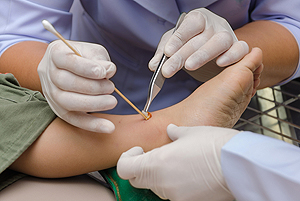 A major problem among those who suffer from diabetes is poor blood circulation and nerve damage. This can lead to diabetics developing foot ulcers that don’t heal properly or quickly. In more severe cases in which the wound has become infected, this can lead to amputation. The first step is to keep the diabetes in check by observing blood glucose levels and staying healthy. Inspecting the foot daily is important because nerve damage can prevent a diabetic from realizing they have an ulcer. Foot inspections can help diabetics discover a wound early so they can alert a podiatrist. If there is a wound, diabetics should wash the wound with saline or clean water. Applying an antibiotic ointment and covering with a bandage is also important. However these solutions are only temporary, and you should see a podiatrist if you have a foot ulcer.
A major problem among those who suffer from diabetes is poor blood circulation and nerve damage. This can lead to diabetics developing foot ulcers that don’t heal properly or quickly. In more severe cases in which the wound has become infected, this can lead to amputation. The first step is to keep the diabetes in check by observing blood glucose levels and staying healthy. Inspecting the foot daily is important because nerve damage can prevent a diabetic from realizing they have an ulcer. Foot inspections can help diabetics discover a wound early so they can alert a podiatrist. If there is a wound, diabetics should wash the wound with saline or clean water. Applying an antibiotic ointment and covering with a bandage is also important. However these solutions are only temporary, and you should see a podiatrist if you have a foot ulcer.
Diabetic foot care is important in preventing foot ailments such as ulcers. If you are suffering from diabetes or have any other concerns about your feet, contact our podiatrists from Greater Queens Podiatry, PLLC. Our doctors can provide the care you need to keep you pain-free and on your feet.
Diabetic Foot Care
Diabetes affects millions of people every year. The condition can damage blood vessels in many parts of the body, especially the feet. Because of this, taking care of your feet is essential if you have diabetes, and having a podiatrist help monitor your foot health is highly recommended.
The Importance of Caring for Your Feet
Patients with diabetes should have their doctor monitor their blood levels, as blood sugar levels play such a huge role in diabetic care. Monitoring these levels on a regular basis is highly advised.
It is always best to inform your healthcare professional of any concerns you may have regarding your feet, especially for diabetic patients. Early treatment and routine foot examinations are keys to maintaining proper health, especially because severe complications can arise if proper treatment is not applied.
If you have any questions please feel free to contact our office located in Bayside, NY. We offer the newest diagnostic and treatment technologies for all your foot and ankle needs.
Read more about How to Care for Diabetic Foot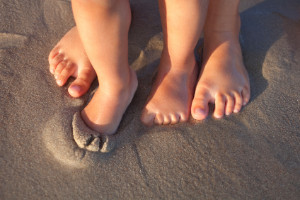 While buying shoes for children can be tough, it is important. Children’s feet are still developing and growing, and their shoes have to reflect this. It’s a good idea to measure a child’s foot before buying shoes. When they try on the shoe, check to see if they can wiggle their toes around. If they can’t, look for shoes that are either longer or wider. Even after buying a pair of shoes, it is recommended to keep measuring them every few months to see if they still fit. Children’s feet grow quickly, and their shoes can be subject to more wear than those of adults. Consequently, replacing shoes every few months may not be uncommon.
While buying shoes for children can be tough, it is important. Children’s feet are still developing and growing, and their shoes have to reflect this. It’s a good idea to measure a child’s foot before buying shoes. When they try on the shoe, check to see if they can wiggle their toes around. If they can’t, look for shoes that are either longer or wider. Even after buying a pair of shoes, it is recommended to keep measuring them every few months to see if they still fit. Children’s feet grow quickly, and their shoes can be subject to more wear than those of adults. Consequently, replacing shoes every few months may not be uncommon.
Making sure that your children maintain good foot health is very important as they grow. If you have any questions, contact our podiatrists of Greater Queens Podiatry, PLLC. Our doctors can provide the care you need to keep you pain-free and on your feet.
Keeping Children's Feet Healthy
Having healthy feet during childhood can help prevent medical problems later in life, namely in the back and legs. As children grow, their feet require different types of care. Here are some things to consider...
Although babies do not walk yet, it is still very important to take care of their feet.
Avoid putting tight shoes or socks on his or her feet.
Allow the baby to stretch and kick his or her feet to feel comfortable.
As a toddler, kids are now on the move and begin to develop differently. At this age, toddlers are getting a feel for walking, so don’t be alarmed if your toddler is unsteady or ‘walks funny’.
As your child gets older, it is important to teach them how to take care of their feet.
Show them proper hygiene to prevent infections such as fungus.
Be watchful for any pain or injury.
Have all injuries checked by a doctor as soon as possible.
Comfortable, protective shoes should always be worn, especially at play.
If you have any questions please feel free to contact our office located in Bayside, NY. We offer the newest diagnostic and treatment technologies for all your foot and ankle needs.
Read more about What to Do to Keep Your Child’s Feet Healthy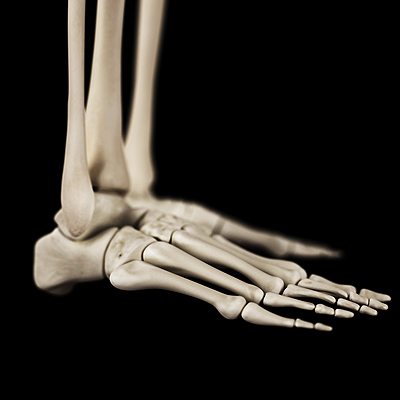 Stress fractures, or painful hairline fractures of the bone caused by fatigue, can happen to anyone. While small, they can be serious if not taken care of. Treatment generally involves rest, but prevention is always preferential. To prevent stress fractures, start with upping your calcium and vitamin D intake. Both calcium and vitamin D help promote healthy bones, which can prevent fractures. A good pair of sneakers can help prevent stress fractures in addition to a number of other foot injuries. At least one study shows that improper running stride can increase the likelihood of injury. Those who are very skinny are more likely to suffer from fractures, so maintaining a healthy body weight and diet is essential. Last but not least, when exercising be sure to gradually increase intensity over time; do not do this immediately. Fatigue from overuse is a common cause for stress fractures, so knowing your limit is an important part of preventing injury. If you think you have suffered a stress fracture in the foot, see a podiatrist immediately for a proper diagnosis.
Stress fractures, or painful hairline fractures of the bone caused by fatigue, can happen to anyone. While small, they can be serious if not taken care of. Treatment generally involves rest, but prevention is always preferential. To prevent stress fractures, start with upping your calcium and vitamin D intake. Both calcium and vitamin D help promote healthy bones, which can prevent fractures. A good pair of sneakers can help prevent stress fractures in addition to a number of other foot injuries. At least one study shows that improper running stride can increase the likelihood of injury. Those who are very skinny are more likely to suffer from fractures, so maintaining a healthy body weight and diet is essential. Last but not least, when exercising be sure to gradually increase intensity over time; do not do this immediately. Fatigue from overuse is a common cause for stress fractures, so knowing your limit is an important part of preventing injury. If you think you have suffered a stress fracture in the foot, see a podiatrist immediately for a proper diagnosis.
Activities where too much pressure is put on the feet can cause stress fractures. To learn more, contact our podiatrists from Greater Queens Podiatry, PLLC. Our doctors can provide the care you need to keep your pain free and on your feet.
Dealing with Stress Fractures of the Foot and Ankle
Stress fractures occur in the foot and ankle when muscles in these areas weaken from too much or too little use. The feet and ankles then lose support when walking or running from the impact of the ground. Since there is no protection, the bones receive the full impact of each step. Stress on the feet can cause cracks to form in the bones, thus creating stress fractures.
What Are Stress Fractures?
Stress fractures occur frequently in individuals whose daily activities cause great impact on the feet and ankles. Stress factors are most common among:
Symptoms
Pain from the fractures occur in the area of the fractures and can be constant or intermittent. It will often cause sharp or dull pain with swelling and tenderness. Engaging in any kind of activity which involves high impact will aggravate pain.
If you have any questions please feel free to contact our office located in Bayside, NY. We offer the newest diagnostic and treatment technologies for all your foot and ankle needs.
Read more about Dealing with Stress Fractures of the Foot and Ankle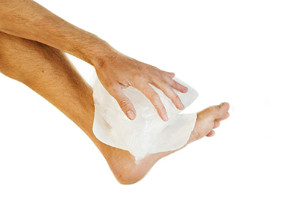 Arsenal Football Club forward Alexis Sanchez recently sustained an ankle injury while training with the Chilean soccer team. He was seen leaving the training field with an ice pack on his left ankle. Sanchez is currently being monitored by medical personnel, but they are confident he can play past the pain. Arsenal has lost several games already; potentially losing one of their best players will be a tough blow to the Gunners.
Arsenal Football Club forward Alexis Sanchez recently sustained an ankle injury while training with the Chilean soccer team. He was seen leaving the training field with an ice pack on his left ankle. Sanchez is currently being monitored by medical personnel, but they are confident he can play past the pain. Arsenal has lost several games already; potentially losing one of their best players will be a tough blow to the Gunners.
Sports related foot and ankle injuries require proper treatment before players can go back to their regular routines. For more information, contact our podiatrists of Greater Queens Podiatry, PLLC. Our doctors can provide the care you need to keep you pain-free and on your feet.
Sports Related Foot and Ankle Injuries
Foot and ankle injuries are a common occurrence when it comes to athletes of any sport. While many athletes dismiss the initial aches and pains, the truth is that ignoring potential foot and ankle injuries can lead to serious problems. As athletes continue to place pressure and strain the area further, a mild injury can turn into something as serious as a rupture and may lead to a permanent disability. There are many factors that contribute to sports related foot and ankle injuries, which include failure to warm up properly, not providing support or wearing bad footwear. Common injuries and conditions athletes face, including:
Sports related injuries are commonly treated using the RICE method. This includes rest, applying ice to the injured area, compression and elevating the ankle. More serious sprains and injuries may require surgery, which could include arthroscopic and reconstructive surgery. Rehabilitation and therapy may also be required in order to get any recovering athlete to become fully functional again. Any unusual aches and pains an athlete sustains must be evaluated by a licensed, reputable medical professional.
If you have any questions please feel free to contact our office located in Bayside, NY. We offer the newest diagnostic and treatment technologies for all your foot and ankle needs.
Read more about Sports Related Foot And Ankle Injuries First time runners should take heed of advice and be careful. It’s not uncommon for beginners to injure themselves during their first time out, as many runners try to go too fast on their first run and burn themselves out. Go at a slower, more moderate pace on your first few runs. Suddenly increasing and lowering your pace can also help prevent your body from getting use to the workouts. Making a schedule that works around your job is also important, as this will allow you to properly plan out your running and recovery times. Allowing your body to heal is important for building muscle and preventing injuries. Never push yourself too hard, and make long term goals rather than short quick ones. It is also important to see a podiatrist who can make sure running is right for you.
First time runners should take heed of advice and be careful. It’s not uncommon for beginners to injure themselves during their first time out, as many runners try to go too fast on their first run and burn themselves out. Go at a slower, more moderate pace on your first few runs. Suddenly increasing and lowering your pace can also help prevent your body from getting use to the workouts. Making a schedule that works around your job is also important, as this will allow you to properly plan out your running and recovery times. Allowing your body to heal is important for building muscle and preventing injuries. Never push yourself too hard, and make long term goals rather than short quick ones. It is also important to see a podiatrist who can make sure running is right for you.
Exercising your feet regularly with the proper foot wear is a great way to prevent injuries. If you have any concerns about your feet, contact our podiatrists of Greater Queens Podiatry, PLLC. Our doctors will treat your foot and ankle needs.
How to Prevent Running Injuries
Many common running injuries are caused by overuse and overtraining. When the back of the kneecap starts wearing out and starts causing pain in your knee, this is commonly referred to as runner’s knee. Runner’s knee is a decrease in strength in your quadriceps and can occur if you’re not wearing properly fitted or supporting shoes. To prevent runner’s knee, focusing on hip strengthening is a good idea, as well as strengthening your quads to keep the kneecaps aligned.
What Are Some Causes of Running Injuries?
- One cause of a common running injury is called iliotibial band syndrome.
- Plantar fasciitis is also another common injury.
- Stress fractures can occur from overtraining, lack of calcium, or even your running style.
Best Ways to Prevent Running Injuries
- Wear footwear that fits properly and suits your running needs.
- Running shoes are the only protective gear that runners have to safeguard them from injury.
- Make a training schedule. Adding strengthening exercises as well as regular stretching can help keep you strong and limber and can lessen the possibility of injuries.
- Stretching keeps muscles limber; this will help you gain better flexibility.
If you have any questions please feel free to contact our office located in Bayside, NY. We offer the newest diagnostic and treatment technologies for all your foot and ankle needs.
Read more about How to Prevent Running Injuries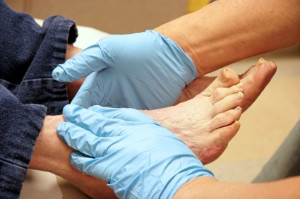 People with diabetes should be very careful when dealing with their feet. Although issues such as foot sores may seem miniscule, they can easily lead to an ulcer for diabetics. Diabetes can cause a lot of complications within the feet. Diabetic foot ulcers can occur anywhere on the foot, but they typically are found on the ball or on the base of the big toe. These ulcers may be caused by wearing shoes that rub against the skin or they can be caused by injury. If you want to prevent getting ulcers on your feet, you should wash your feet on a daily basis with mild soap in warm water. Moisturization is crucial, but be sure not to put lotion between your toes. Daily foot inspections may also be helpful, and it is recommended that you do so twice a day.
People with diabetes should be very careful when dealing with their feet. Although issues such as foot sores may seem miniscule, they can easily lead to an ulcer for diabetics. Diabetes can cause a lot of complications within the feet. Diabetic foot ulcers can occur anywhere on the foot, but they typically are found on the ball or on the base of the big toe. These ulcers may be caused by wearing shoes that rub against the skin or they can be caused by injury. If you want to prevent getting ulcers on your feet, you should wash your feet on a daily basis with mild soap in warm water. Moisturization is crucial, but be sure not to put lotion between your toes. Daily foot inspections may also be helpful, and it is recommended that you do so twice a day.
Diabetic foot care is important in preventing foot ailments such as ulcers. If you are suffering from diabetes or have any other concerns about your feet, contact our podiatrists from Greater Queens Podiatry, PLLC. Our doctors can provide the care you need to keep you pain-free and on your feet.
Diabetic Foot Care
Diabetes affects millions of people every year. The condition can damage blood vessels in many parts of the body, especially the feet. Because of this, taking care of your feet is essential if you have diabetes, and having a podiatrist help monitor your foot health is highly recommended.
The Importance of Caring for Your Feet
Patients with diabetes should have their doctor monitor their blood levels, as blood sugar levels play such a huge role in diabetic care. Monitoring these levels on a regular basis is highly advised.
It is always best to inform your healthcare professional of any concerns you may have regarding your feet, especially for diabetic patients. Early treatment and routine foot examinations are keys to maintaining proper health, especially because severe complications can arise if proper treatment is not applied.
If you have any questions please feel free to contact our office located in Bayside, NY. We offer the newest diagnostic and treatment technologies for all your foot and ankle needs.
Read more about How to Care for Diabetic Foot| Bayside Office 4401 Francis Lewis Blvd Suite L3B Bayside, NY 11361 Phone: (718) 229-0222 Fax: (718) 717-0275 | Monday: 9:30am - 7pm |
E-mail us with any questions